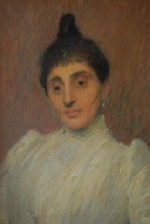Elena Bibescu in George Enescu's Home
Elena Bibescu in George Enescu's Home
 The
sole painted portrait of Princess Elena Bibescu will be exhibited
at the "George Enescu' National Museum.
The
sole painted portrait of Princess Elena Bibescu will be exhibited
at the "George Enescu' National Museum.
The sole painted portrait of Elena Bibescu, significant figure towards
the end of the 19th century, to whom George Enescu owes his debut
in the Parisian cultural life, was purchased by the "George Enescu'
National Museum. It will be part of the permanent exhibition of the
Bucharest cultural institution.
The painting was won by the "Enescu' Museum in an auction that was
held at the Drouot Hotel in Paris, one of the most important auction
houses in the world, specialized in selling antiques. Participating
in an international auction is a premiere for the Bucharest Museum,
which paid EUR 4,800 for this work of art. The director of the museum,
Laura Manolache, stated for Evenimentul Zilei that the "painting found
its rightful place at the "George Enescu' National Museum, given that
the relationship between Enescu and Princess Elena Bibescu represents
a key element in understanding this musician's exceptional career.'
The Royal Pianist
Princess Elena Bibescu was the daughter of Manolache Kostaki Epureanu,
Minister and Prime Minister during the reign of Alexandru Ioan Cuza
and Carol I. She was also the wife of Prince Alexandru Bibescu. Princess
Elena studied piano with Anton Rubinstein at the Conservatory in Vienna,
specializing afterwards in interpretative art, in Paris, with Marc
de la Nux. Unfortunately, she is less known nowadays, which is also
caused by the fact that there are no recordings of her performances
(the princess preferred giving recitals in her own parlour).
"Vice-mother' of George Enescu
Last year, on March 5th, Radio Romania Music broadcast a report from
the launching of the book called Princess Elena Bibescu -the Great
Pianist, signed by C. D. Zeletin. The author also talks about the
famous artistic and literary parlour -visited by figures such as Marcel
Proust, Charles Gounod, Ernest Chausson or Gabriel Fauré -held by
the aristocrat in Paris for over thirty years. One of the great merits
of Elena Bibescu was that of launching George Enescu in the Parisian
cultural life. The moment is highlighted by C. D. Zeletin, in his
book (page 15): "in the long life of a human being, one can discover
the existence of a peak moment whose meaning can or cannot be grasped.
(...) It is the great event of life; it is the moment that creates
(...). For princess Bibescu, this moment was George Enescu's debut
as a composer in Paris, 1898, with Poème roumain.' Indeed, Enescu
was constantly supported by the one known to Parisians as Hélène Bibesco;
after graduating from the Vienna Conservatory, the composer continued
his studies at the Conservatoire de Paris and made his debut in the
Colonne Concerts, thanks to Elena Bibescu. As a sign of gratitude
for the one whom he would not call "vice-mother' in public, Enescu
dedicated several compositions to Princess Bibescu.
The Painting Signed by Henri Martin
The portrait of Princess Elena Bibescu signed by French painter Henri
Martin is described by art critique Gabriel Badea Paun - who currently
lives in Paris and who informed the board of the Enescu Museum regarding
the sale of the painting -Tuse scurte, paralele - a result of the
Neo-impressionist current, recreates the shape of the model in an
ideal chromatic palette. The work is placed in a Neo-gothic frame,
designed especially for this purpose, which accentuates the impression
of reverie, placing the painting in an era beyond the limits of time,
a theme dear to the symbolists, whose ideals were definitely shared
by the patron of the painting and by the painter himself. It is, I
believe Henri Martin's only work exhibited in a Romanian museum',
added Gabriel Badea Paun for Evenimentul Zilei.
Exhibition of the Painting
Laura Manolache, administrator of the "George Enescu' National Museumannounced
during an interview given to our radio station that the painting will
be exhibited beginning with May 5th at the Cantacuzino Palace Hall.
The unveiling ceremony will also host a four-hand recital for piano,
courtesy of musicians Corina Raducanu and Eugen Dumitrescu. .
Translated by Andreea Banciu
MA Student, MTTLC, Bucharest University














